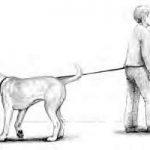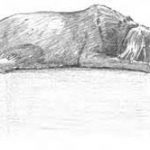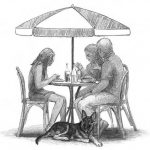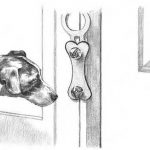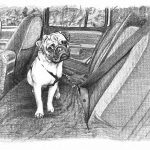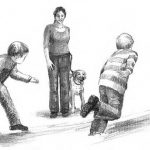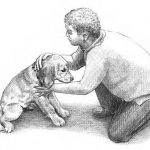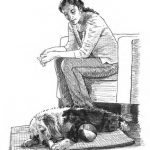Ten Common Misunderstandings


In This Chapter
- Knowing what hugs, kisses, and tail wags mean to dogs
- Understanding the expression of guilt and spite in dogs
- Exploring what leadership and control mean in the dog’s eyes
- Recognizing how your stress affects your dog
It seems that everyone believes that they understand dogs and dog behaviors — at least well enough to get along with their own pet. They base this belief on “facts” that they may have heard from their parents, friends, and acquaintances.
Unfortunately, acting on such misinformation can result in bad outcomes, a sharp deterioration in trust, and possibly increased aggression. In this chapter, we replace folk tales with fact.
Just For FunTrue or false? In North America, one out of every four families lives with a dog! True, true, true!
Every Dog Wants to Be Leader of the Pack
Dogs don’t have humanlike ambitions: Being No. 1 dog in their family pack is more of a burden than an honor. The truth is that dogs simply want their human pack members to assign them a rank number and to make the decisions. With someone else making the decisions, the dog doesn’t have to ever be on guard and can now tend to the other matters on his agenda, such as an afternoon nap or a game of fetch.
The rank in the pack doesn’t have to be earned by physical force. A strong pack leader controls access to food, resting spots, and water and has a stable mood. In fact, the only return this leader expects is attention and respect from his group.
TipThe simple act of making a dog work for everything he wants, such as obeying a simple command like “Sit” before being given dinner, or even being given a pat, tells him that you’re in charge.
RememberWithout an authority figure and adequate pack structure, your dog will become quite stressed. This stress is the source of many dog behavior problems. These problems come about because the dog thinks, “If no one in my pack is in charge, then someone must make the decisions, and the only one left is me.” Thus, the unwilling dog is forced into a position of leadership. He must then be ever vigilant and becomes pushy, dominant, and even aggressive.
A Wagging Tail Means a Happy and Friendly Dog
A wagging tail signifying a friendly dog is one of the most common misunderstandings about dog behavior. Actually, the wag of a dog’s tail can signal many things, depending upon its speed and the way the tail is carried.
A happy tail wag is actually a submissive gesture and one that is often paired with a lower rump, which seems to drag the hips with each swing. Translated, it says, “You have my respect, and I know that you won’t hurt me.” A dog giving this signal is quite approachable.
Contrast that broad tail wag with one where the dog’s tail is held high over his back and the tail movements involve very short side to side swings at a high speed. This is the tail wag of a dominant dog who is saying, “Back off! Give me space!”
For a more thorough description of tail interpretation, refer to Communicating with Your Dog.
Dogs Understand Human Language
How many patient pets have listened to the constant diatribes of their well-meaning owners: “How many times have I told you not to get on the sofa? Behavior like that is simply not acceptable, and you’re making me very angry. I don’t want you to do that again.”
Ask the person, and he may claim that his dog knows well and good what he’s talking about. Ask the dog, but she’ll likely be snoring.
Dogs can learn specific words that humans speak, with the average dog capable of learning around 165 words and/or signals. In addition, dogs are very attuned to tone of voice and instinctively pair it to an emotional state, thus people with deep voices are often given reverence, whereas doting, placating family members are often ignored.
RememberA dog, no matter how intelligent, can’t process full grammatical sentences.
A Fearful Dog Won’t Bite
A dog cringing in fear is a sorry sight. The average person may feel drawn to the scene and eager to help, but few consider this frightened animal a threat. Approaching this dog, however, is a bad move. This dog fears for his life and will likely bite without warning or hesitation. When fear biters bite, they bite hard.
Warning!Fearful animals are, in fact, more likely to bite than dominant animals.
Panic drives fearful dogs to do anything to reduce the presence of a threat. Further, when you retreat from a dominant dog, he’ll stop any further threat of aggression: In essence, you did what he asked. When you retreat from a fearful dog, however, he may still rush and snap as your presence is still a potential threat. He’s afraid that you may still return to hurt him, so his emotions may well swamp any logical thinking about the situation.
Warning!You should view all frightened animals as potentially aggressive.
Dogs Know When They’ve Done Wrong
Here’s the scene. You enter your home, and Rover looks at you, glances toward the kitchen, and then runs and hides. You walk into the kitchen, and trash is strewn all over the place — evidence that once again, your pet has been looking for edibles in the garbage. Your conclusion is obvious: Rover was feeling guilty because he messed with the trash can, and he knew that he’d done something bad, which is why he is hiding from you.
Unfortunately, your obvious conclusion is wrong. Remember, dogs have the mind equivalent of a 2- to 21/2 -year-old human.
Feelings of guilt don’t appear until around 4 years of age in humans, and notions of right and wrong may not be fully formed even in adults.
So what’s going on here? Your dog has learned that when trash is on the floor and you enter the house, bad things happen to dogs. He has no notion that he has any responsibility for the connection. He’s simply showing fear for the punishment that he anticipates may occur.
TipIf your dog has such a trash problem and you still believe that your dog feels guilt, strew some trash on the kitchen floor yourself, let Rover see it, and then leave the house for five minutes. When you return, you’ll see your dog cringing in the same manner that you call guilt, even though he knows that he’s not responsible.
Dogs Sometimes Behave Out of Spite
Maggie has been out running errands all day while her dog Buddy was home alone. When she finally comes home, she finds the sofa cushions chewed to shreds. When her husband comes in from work, she explains, “Buddy was so upset that I left him for so long that out of spite and revenge, he destroyed our furniture.”
It’s a nice story, but wrong. Spite is another late developing emotion, like guilt, and the minds of dogs (equivalent to a human 2 year old) never reach that stage. Buddy chewed the cushions out of boredom. If he’d had something more interesting to chew on, like a beef shank bone or a peanut butter–filled chew toy, Maggie’s sofa would still be intact.
TipAnother reason dogs choose to destroy or carry objects is that they may have your scent. Objects with the strongest scent are apt to be objects that you use frequently, so you naturally believe that the dog has deliberately chosen that object to distress or annoy you. However, this behavior is driven by a longing for your company, not a spiteful reaction to your departure.
Dogs Hate Cats
Dogs naturally chase cats, but this reaction isn’t motivated by hatred. Dogs evolved from predators that chased, killed, and ate a lot of small animals, although their ready access to the food that we provide has diminished their killing instinct. Term it call of the wild or simple fun, dogs naturally chase any animal that runs from them — including cats. Sighthounds and terriers are the breeds most likely to chase cats.
Unlike other wild prey, however, when trapped, a cat will turn and fight. Such a confrontation is noisy and dangerous for both animals, and if you’ve experienced such an event, you’d certainly remember it. However, if you look at the statistics, you’ll note 56 percent of dog owners also own cats, and they happily coexist, meaning that harmony between the species is within your reach.
Dogs Like It When You Hug Them
Most dogs don’t enjoy being hugged. It’s nothing personal, but as part of their wild heritage, dogs interpret any restriction of motion as threatening because running from trouble is their first line of defense. Though most dogs will tolerate a strong pat or quick arm hold, a full hug may be too restraining.
TipTeach your children how to interact with dogs properly. Encourage your children to reach out their hands to allow a dog to sniff it. If the dog turns away, your children should, too. If the dog sniffs their hand calmly, show your children the appropriate way to stroke and pet them, but enforce absolutely no hugs!
Your Stress Has No Effect on Your Dog
Most people believe that their stress level has no effect on their pet’s well-being and look to their pets as potential sources of stress relief for their human family. Though scientific data has confirmed that petting a dog does relieve stress, studies also show that your state of tension and anxiety can affect your dog as well.
When you’re anxious, you emit scents called pheromones that signal your current psychological state to your dog. When stress scents are emitted, your dog will search for the source of danger that is causing your agitated state. His activity level may rise, as he becomes anxious and ill at ease. He may even think that your stress has been caused by something that he did. Your tension thus becomes your dog’s tension, too.
Dogs are masters at reading body language, too. They can detect your mood by looking at your posture and the way that you move.
TipAvoid working with your dog when you’re stressed. Use this time to relax or play games that may lighten your mood before you train or do other work with your pet.
Dogs’ Licks Are Kisses
Probably one of the most enduring and widespread myths about dog behavior is that a dog’s lick is the equivalent of a kiss. Actually, a dog’s lick can have many meanings, and affection and greeting are only two.
Perhaps the most common meaning comes from a dog’s early evolutionary history. In the wild, when a mother wolf returns from hunting, she has already fed herself. When she enters the den, the puppies gather around her and begin to lick her face. To a romantic, this gesture may look like expressions of love — with all the puppies overjoyed at mother’s return. The actual purpose of this face licking, however, is much more functional.
Wild canines have a well-developed regurgitation reflex. Young puppies who are no longer nursing lick their mother’s face and lips to cause her to vomit up food. This partially digested material is easy for the mother to transport and makes ideal dining for young puppies.
So the next time your dog is licking your face, ask yourself whether he’s hungry. Perhaps he’s simply asking for something to eat. Of course, humans, being easily flattered, often reward what they perceive as loving attention with a snack. And so it comes full circle.
by Stanley Coren and Sarah Hodgson









